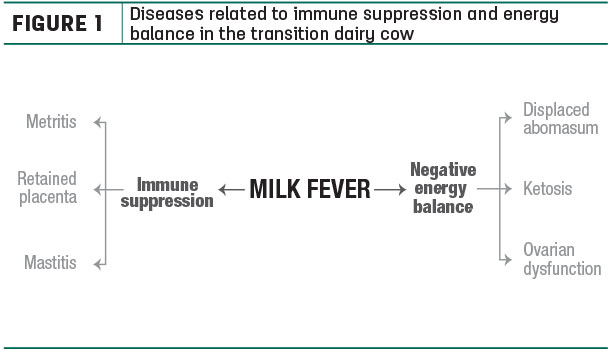The transition period for a dairy cow has traditionally been defined by the dairy industry as the period three weeks pre-calving to three weeks post-calving. An expanded period including the entire dry period, i.e., 60 days pre-calving to 30 days post-calving, more completely encompasses the actual period when physiological and nutritional adjustments result in a successful subsequent lactation.
Furthermore, during this period, many of the common dairy disease problems are observed, including hypocalcemia, displaced abomasum, ketosis, retained placenta, metritis and mastitis, which are linked to energy balance or immune suppression (Figure 1).
 Numerous physiological and metabolic changes (i.e., transitions) occur during the dry and early lactation periods in the dairy cow. These changes include:
Numerous physiological and metabolic changes (i.e., transitions) occur during the dry and early lactation periods in the dairy cow. These changes include:
- Cessation of milking at dry-off
- Changes in environment and ration composition
- Rapid fetal growth
- Decline in dry matter intake just prior to calving
- Initiation of colostrum production
- Hormonal changes, including declining progesterone and rising estrogen blood levels
- The process of giving birth
- Rapid increase in milk production
Along with physiological adjustments associated with transition, energy requirements essentially double overnight at the time of calving. Besides the demand for additional glucose for early lactation, energy balance is further compromised by a decline in feed intake in the peripartum cow.
The physiologic and metabolic changes occurring during transition also negatively affects immune function in the periparturient cow. The immune response was significantly reduced in the days just prior to and immediately post-calving.
If immune function is impaired or suppressed, the cow becomes more susceptible to a number of periparturient disease conditions such as retained fetal membranes, metritis and mastitis.
The immune system and mastitis
Immunity encompasses a number of complex interactions designed to protect the cow from infection by a number of microbial organisms. The immune system is characterized by two primary branches: acquired immunity and innate immunity. Acquired immunity refers to the portion of the immune system commonly associated with antibody generation. Immunity develops in response to first exposure to an antigen (foreign protein) such as bacteria, virus or a vaccine antigen.
Immune response can be cell-mediated or humoral and usually requires days to weeks to completely develop. Acquired immunity is generally specific to an organism and has “memory” such that it specifically responds to repeat exposure to that agent. The primary defense cell associated with acquired immunity is the lymphocyte, the white blood cell involved in antibody production.
In contrast to acquired immunity, innate immunity is non-specific and has no memory of prior exposures. The nonspecific components of innate immunity include physical barriers, such as the teat canal, inflammation and a phagocytic response. The innate response to microbial exposure is extremely rapid and very consistent.
The primary defense cells in the innate system are neutrophils and macrophages. They commonly destroy bacteria by phagocytosis, which involves engulfing and digestion of invading bacteria.
Neutrophils respond to the inflammatory signals from an intramammary infection by migrating, in large numbers, from the bloodstream into mammary tissue. During early inflammation, 90 percent of the cells (somatic cells) present in the udder are neutrophils.
Immune function is impaired in early lactation by a number of factors including hypocalcemia, glucocorticoids, insufficient energy and elevated circulating ketones. Impaired immunity is characterized by a reduced number of neutrophils in circulation and a reduction on their ability to kill bacteria.
Over the years, researchers have had limited success with developing vaccines against common mastitis pathogens. Part of the problem with vaccinating against mastitis is the diversification among species of the organisms that cause the disease, especially gram-positive species.
To date, no vaccine has demonstrated efficacy against environmental streptococci or Staphylococcus aureus. However, some success has been observed in immunizing dairy cattle with an E. coli J5 bacterin during the dry period and in early lactation. In general, these vaccines reduce the severity of clinical coliform mastitis in early lactation.
Dairy cows experience a 25 to 40 percent decline in immunity around the time of giving birth. Improving energy balance via adequate nutrition, providing a clean environment and strategic immunization have traditionally been key components in restoring normal immune function and disease resistance in the dry and transition periods.
Other tools, such as use of dry cow intramammary antibiotic infusions, teat sealants and vaccines, also reduce the incidence of new intramammary infections or eliminate existing infections.
Recently, an immunomodulator, bovine pegbovigrastim injection was approved for use in the U.S. This product helps restore the integrity of the cow’s innate immune system during the period the cow normally experiences immune suppression.
Conclusion
The dairy cow going from a dry/pregnant state to lactation undergoes a number of transitions, including a drop in nutrient intake and suppression of the immune system. These changes make the cow more susceptible to common periparturient disease problems including hypocalcemia, displaced abomasum, ketosis, retained placenta, metritis and mastitis.
Over the years, numerous management and treatment strategies have been introduced to help control these conditions, especially mastitis; practices such as maintaining a clean environment for dry and calving cows, strategic grouping of close-up cows, specific feeding programs for dry cows, use of intramammary dry cow therapy, teat sealants and vaccines. ![]()
Dr. Paul Rapnicki is a dairy technical consultant with Elanco Animal Health.
References omitted but are available upon request. Click here to email an editor.

-
David McClary
- Veterinarian - Senior Technical Consultant
- Elanco Animal Health





